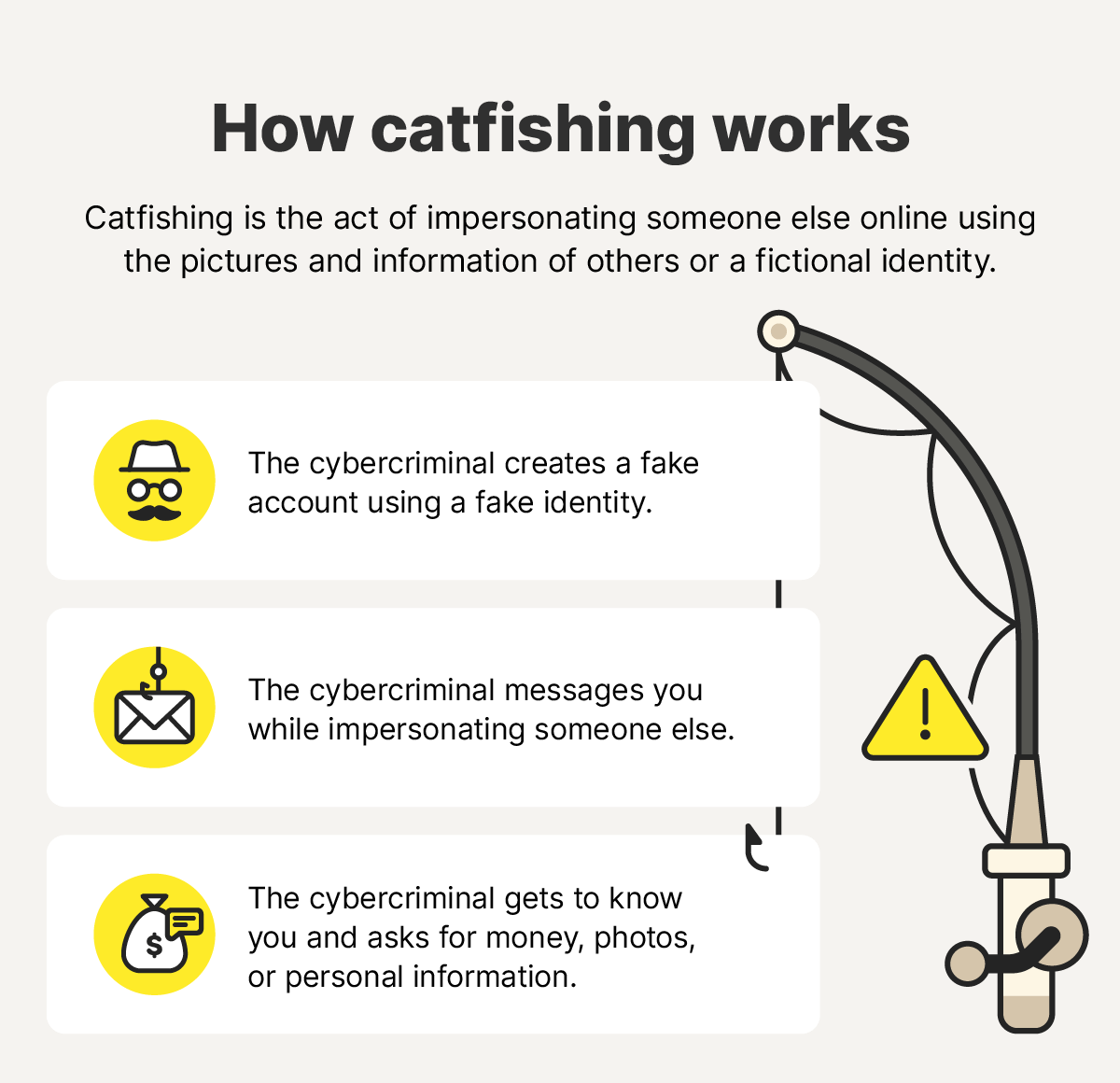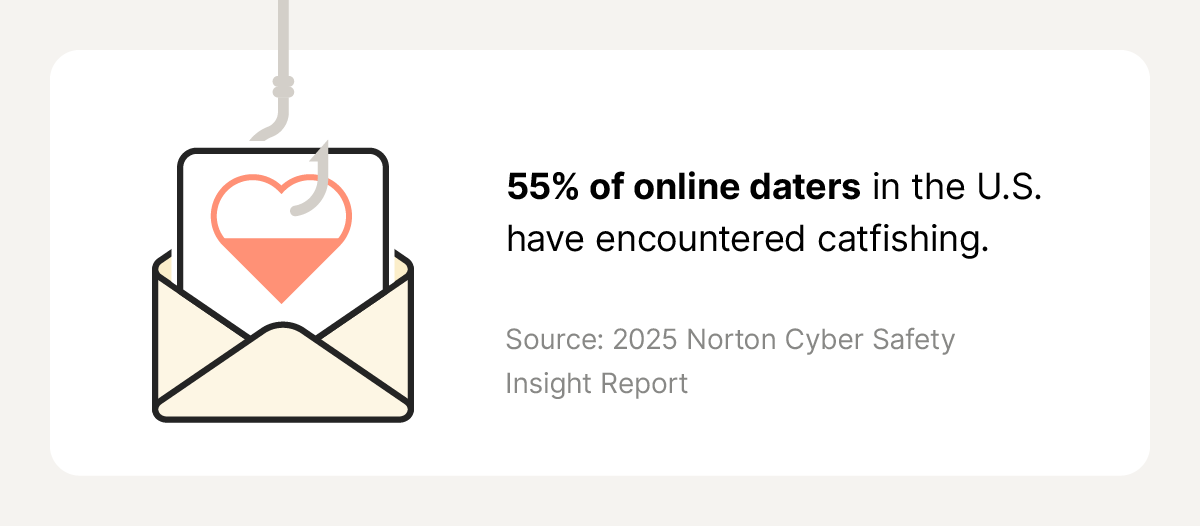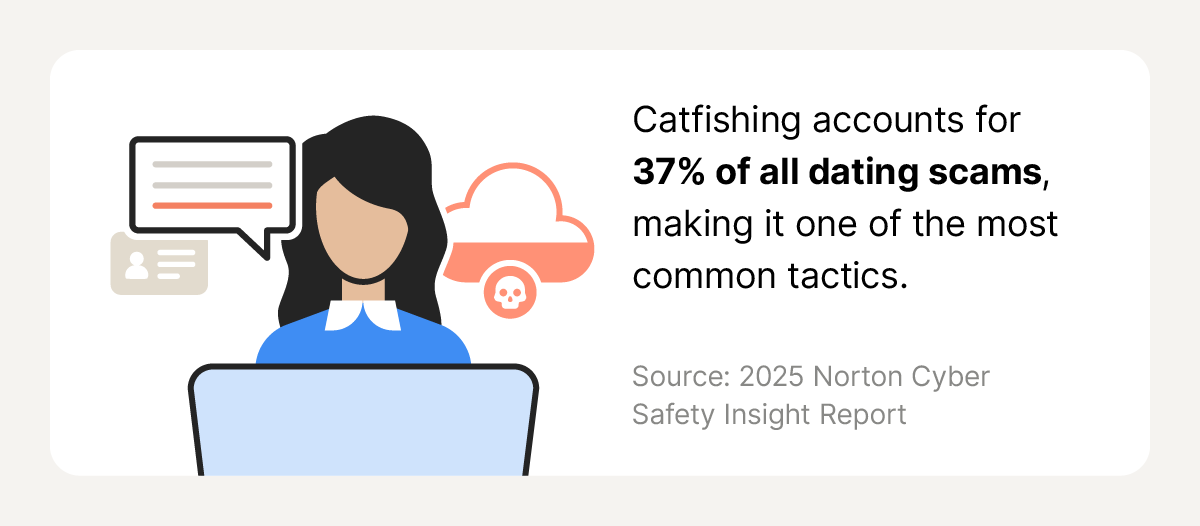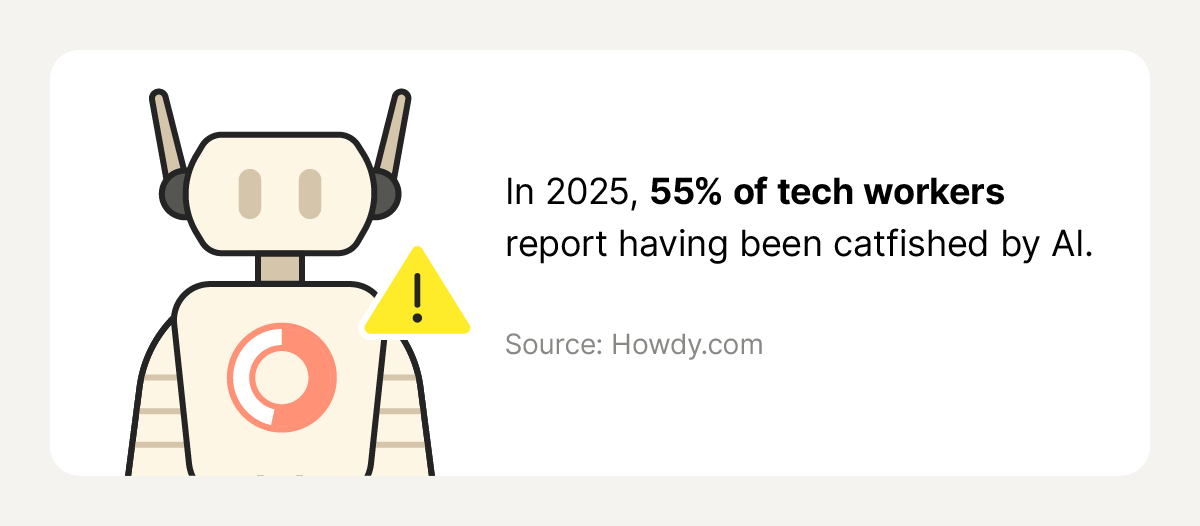What is catfishing? How to spot and avoid it
Catfishing is when someone creates a fake online identity to deceive others, often through romance scams or fake friendships. With AI-generated photos and deepfake videos, these scams are becoming more convincing than ever. Learn what catfishing is and how Norton 360 Deluxe’s AI-powered scam detection can help protect you.

Catfishing, sometimes called catphishing, is a type of scam that involves deceiving someone online by using a fake identity to build a misleading relationship. It is a potentially serious cybercrime that can leave victims with emotional trauma as well as financial loss.
In one recent case in Northern Ireland, 21-year-old Max Hollingsbee was sentenced to five years in prison for catfishing multiple young people online, including a 15-year-old girl he coerced into sharing private images.
Unfortunately, Hollingsbee’s case is far from an isolated incident. The scale of these scams is staggering. The 2025 Norton Cyber Safety Insight Report found that 55% of online daters in the U.S. have encountered catfishing.
In this guide, we’ll explore what catfishing is, how to spot the warning signs, and what steps you can take to help protect yourself and your kids.
What does it mean to be catfished?
To be catfished means that someone has attempted to trick you into believing you’re interacting with a real person online, when it’s actually a scammer using a fake or stolen identity. Unlike spoofing, where scammers fake a website or phone number, catfishing involves creating an entire persona.
While catfishing is often associated with romance scams, children and teenagers are also targeted on non-dating platforms.
Catfishing generally happens in three steps:
- Bait: The catfish invents a persona, using stolen photos, names, and personal details, sometimes fabricating an entire life story.
- Hook: They flatter you, mirror your interests, and nurture a sense of connection, so you feel comfortable and invested.
- Reel: Once they’ve established trust, they start asking for favors, financial support, sensitive information, or explicit content.
Catfishing doesn’t just happen on dating apps like Tinder, Bumble, or Hinge. It can begin on social media platforms such as Instagram, Facebook, or Snapchat, and even in messaging apps like WhatsApp and Telegram.
It’s not only about romance, either. People have even been catfished on professional sites like LinkedIn, where fake recruiters launch job scams.


Why do people catfish?
Psychiatrists say there are different motivations behind catfishing, ranging from boredom to financial gain. Many catfishers exhibit personality traits like sadism, narcissism, and psychopathy.
Catfishing can escalate into serious crimes or dangerous situations. For example, in 2022, a man named Austin Lee Edwards allegedly catfished a 15-year-old girl, which tragically led to a triple homicide. This case serves as a reminder of how serious online deception can become, and why staying cautious is so important.
Some reasons people catfish include:
- Mental illness: Some struggling with mental illness may impersonate others to gain confidence when communicating with people online; they may not understand the consequences of their actions.
- Revenge: Some catfishers want to embarrass, harass, or damage their victim’s reputation as a form of cyberbullying.
- Insecurity: If a catfish is insecure and doesn’t like who they are in real life, they may use catfishing as a tool to create an ideal version of themselves.
- Targeted harassment: Certain catfishers may use their fictional identity to harass, bother, or cyberstalk individuals they dislike.
- Sexual exploration: Some catfishers may use their catfishing persona to explore different sexual identities, distinct from the one they inhabit in real life.
- Exploitation: Some catfishers aim to convince their targets to share explicit photos or videos for their own gratification or blackmail.
- Loneliness: If a catfish feels lonely in real life, they may take on a fake persona to anonymously communicate with others online.
- Financial gain: Many catfishers find it to be a lucrative and effective scam tactic. They build trust, then request money from their victims through gift cards or mobile payment apps.


Who are likely catfishing targets?
Catfishers often target younger females and older males. But anyone online can be targeted. Snap Inc. found that 51% of Gen Z teens and young adults claimed they or someone they know had been a target or victim of catfishing.
Young people are often targeted because they may be more likely to share personal information or images, which can be exploited for blackmail. Meanwhile, adults over 60 are often targeted for their retirement savings, and because they are generally less informed about online scams.
Is catfishing illegal?
Creating a fake profile online isn’t automatically a crime. However, using a real person’s name, photos, or personal details without permission, especially to cause harm, can be considered identity theft.
Similarly, if a catfisher scams you, blackmails you, or harasses you, then that’s illegal.
But, authorities can’t catch every scammer, due to the huge amount of resources it would require. A catfisher in one country can target someone across the globe, hiding behind a VPN or using AI-generated profiles. That’s why authorities often prioritize cases with serious financial or physical harm.


9 signs of catfishing to be aware of
Catfishing often involves subtle deception and social engineering tactics. Common signs you’re being catfished include inconsistent stories, reluctance to meet in person or video chat, and requests for money, personal information, or intimate images.
Here are some signs of catfishing that can help you spot if someone online is a real person or a cybercriminal setting you up for a scam.
1. They avoid video calls or meeting up
If someone keeps dodging in-person visits, or video and phone calls, they may be hiding how they really look or sound. Catfishers usually invent excuses, such as travel, family visits, or illness, and often do so at the last minute.
2. Their videos and audio seem AI-generated
Some catfishers use various types of AI to create videos or voice recordings that look and sound real. Deepfakes can be so convincing that even experienced professionals can be fooled.
For example, a finance worker in Hong Kong paid $25 million after a video call with a deepfake “CFO.”


3. They don’t use social media much
Another sign of a catfish is a bare-minimum social media profile. Catfishers often have few followers and rarely interact with other users to avoid exposure. Some of these accounts are used in schemes like sugar daddy scams, while others claim to be searching for a long-term relationship.
4. They have a new profile
If their social media account or dating profile is new or has very few photos, it could be a sign of a catfish. Many catfishers create new profiles to avoid detection or because they’ve been blocked, so may only include a handful of images. Since it’s a fake account, they likely don’t have many connections either.
5. They ask to move to another app
Catfishers often suggest moving your conversations to another app, such as WhatsApp or Telegram, which have weaker monitoring. By doing this, they make it more difficult to be picked up by an app’s security measures, or for you to verify their identity or report them in the future.
Be cautious if someone asks you to move to a different platform, especially if you’ve just started chatting.
6. They ask you for money or information
If someone online asks for money, gifts, or sensitive information, it’s a major warning sign. Catfishers often request money over wire transfers or peer-to-peer apps like Venmo because these payments are nearly impossible to reverse.
They may claim emergencies, travel costs, or other urgent reasons. But never send money to anyone whose identity you can’t confirm and whom you haven’t met in person.
7. They use stolen pictures
One of the biggest indicators of a catfisher is the use of stolen pictures. These photos may be stock images, pictures of a model, or profile pictures from other accounts. You can perform a reverse image search to see if an image has been taken from someone else.
Sometimes catfishers even use images of celebrities to make their profile seem appealing. For example, LPGA golfers, like Nelly Korda, warn of scammers creating fake accounts in their names, requesting money from fans.
8. They ask for explicit images or videos
Catfishers, particularly in romance scams, often exploit sensitive images to blackmail victims for money, gifts, or additional explicit content. These scams can be emotionally and financially damaging, so never share intimate material with someone you don’t know and trust.
9. They’re interested in all the same things as you
If someone online seems to love everything you love, it might feel like fate — but it can also be a warning sign. Catfishers often copy your interests to make you trust them and feel a connection. It’s a classic trick to pull you in.
Many catfishers succeed because they dig into personal details from social media, public records, and even data breaches to craft convincing backstories.
Security solutions like Norton 360 Deluxe can help by monitoring the dark web for your info, which may be posted there after a breach. It will alert you if your personal information is found, so you can take action to secure any compromised accounts.
What to do if you fall for a catfishing scam
If you find out that a person you’re talking to isn’t who they say they are, act quickly. Cut off contact immediately to prevent the scammer from reaching you again, and alert both the platform and the relevant authorities.
- Stop all communication: Catfishers may try last-minute appeals to regain your trust. Don’t engage.
- Block them: Block their accounts across all platforms you communicated over.
- Collect evidence: Take screenshots of conversations, profiles, and any payment requests.
- Report them to the website: Social media and dating platforms can suspend or remove fraudulent accounts.
- Report them to the authorities: If you were scammed, report it to the FTC, Better Business Bureau, and the FBI’s scam tracker, which can help prevent the scammer from targeting others.
- Contact your bank: If you sent money, alert your financial institution immediately to attempt recovery of your funds.
- Protect your credit: If you provided sensitive information, consider a credit lock or freeze to help prevent them from opening new credit in your name.
How to protect yourself from catfishing
To help protect yourself from catfishing, be cautious in online chats, verify identities, and ask specific questions. The following tactics can also help you avoid other social media threats.
- Be suspicious of online chats: If you notice the person trying to rapidly escalate your relationship, take a step back and assess their online profile before you continue engaging with them.
- Don’t share images or videos: Never send private content to someone you don’t know. Catfishers often use these for blackmail or extortion schemes.
- Ask for a video call: Request a live video call to confirm their identity. Repeated excuses or refusals are a warning sign that they’re hiding something.
- Run a reverse image search: Perform a reverse image search to verify that a person’s pictures are actually their own. You may find a stolen image or stock photo has been used on their dating or social media account.
- Search for the person online: Look for consistency across social media platforms. Fake profiles often have few posts, friends, or followers, or use mismatched locations.
- Don’t overshare online: Avoid giving personal details, location info, or travel plans. Even harmless sharenting posts about kids can give catfishers information to manipulate you.
- Ask specific questions: If you suspect you’re dealing with a catfish, ask them questions only someone with their specific background would know. For example, if they say they live in your area, ask them a question only a local could answer.
Stay safer from catfishing attempts
Catfishing keeps evolving with technology like deepfakes and AI-generated content, but paying attention to the warning signs can save you a lot of heartache, not to mention money.
Norton 360 Deluxe gives you extra layers of security with Dark Web Monitoring and AI-Powered Scam Protection. Its Parental Control tools can also help keep your kids safe online. Get it now to cover up to five devices on just one subscription.
Editorial note: Our articles provide educational information for you. Our offerings may not cover or protect against every type of crime, fraud, or threat we write about. Our goal is to increase awareness about Cyber Safety. Please review complete Terms during enrollment or setup. Remember that no one can prevent all identity theft or cybercrime, and that LifeLock does not monitor all transactions at all businesses. The Norton and LifeLock brands are part of Gen Digital Inc.









Want more?
Follow us for all the latest news, tips, and updates.